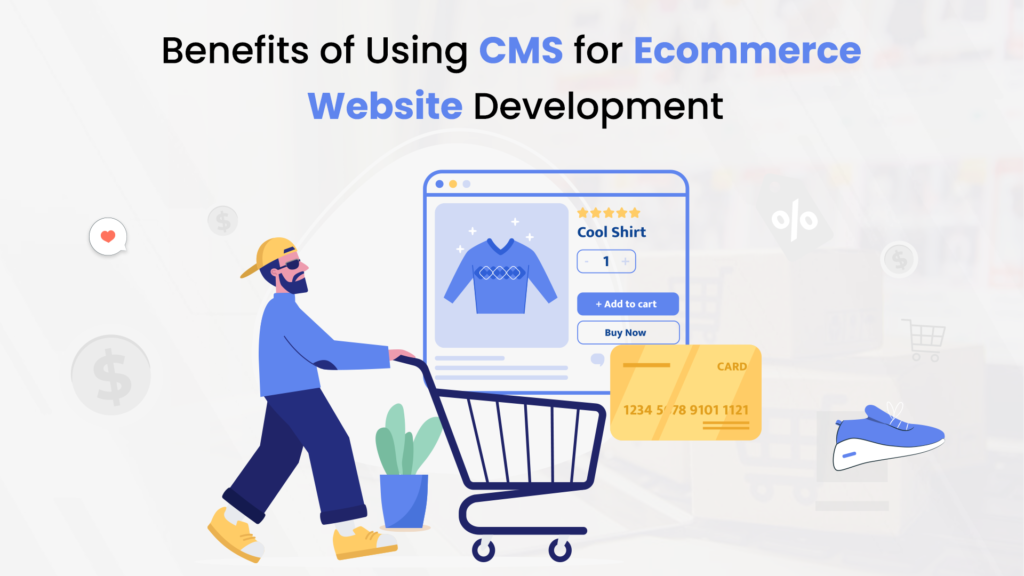For years, Jane had been working at her family’s small brick-and-mortar store. She loved the business but knew that in order to stay competitive, they needed to expand into the digital space. That’s why she decided to take on the daunting task of developing their own ecommerce website. Jane was a quick learner but soon found out that developing a website was not as easy as she thought. She searched the internet for resources, but there was so much information there that she didn’t know where to begin. That’s when she stumbled upon an article titled “Ecommerce Website Development: The Ultimate Guide You Need to Know.” Let’s look into this below:
Introduction
Ecommerce website development involves the creation of an online platform for buying and selling products or services. In recent years, ecommerce has become a most important part of business, enabling companies to reach a wider audience and increase sales. Ecommerce website development requires the use of specialized software and design elements to create a functional and attractive website.
Definition of ecommerce and its significance
Ecommerce, or electronic commerce, refers to the buying and selling of products or services over the Internet. It has grown rapidly in recent years, with more and more businesses embracing online sales. Ecommerce is significant because it provides businesses with the ability to reach a global audience and increase their sales. It also provides customers with the convenience of shopping from their homes, which has become increasingly important in the wake of the COVID-19 pandemic.
The Importance of Ecommerce Website Development in the Digital Age
In the digital age, ecommerce website development is crucial for businesses of all sizes. An ecommerce website enables businesses to reach a global audience and increase their sales. With the rise of mobile devices, having a mobile-friendly ecommerce website is essential to attract and retain customers. Ecommerce websites also provide insights into customer behavior, which can be used to improve marketing strategies and boost sales.
The Early Days of Ecommerce Website Development

Ecommerce website development has come a long way since its early days. In the 1990s, the internet was in its infancy, and the idea of buying and selling products online was relatively new. However, even in those early days, developers were working on creating ecommerce websites to take advantage of this emerging market.
The First Ecommerce Website
A New Hampshire-based company called NetMarket created the first ecommerce website, which they launched in 1994. The NetMarket website, which is widely regarded as the first ecommerce website, sold Sting’s “Ten Summoner’s Tales” album to a customer in Philadelphia. This marked the first secure online transaction, using encryption technology to protect sensitive customer information.
Early Technologies and Tools Used for Ecommerce Website Development
In the early days of ecommerce website development, developers used technologies like HTML, JavaScript, and CGI scripts to create basic online stores. Third-party services such as PayPal and Google Checkout were often used for payment processing, offering customers a secure method of paying for their purchases.
As ecommerce grew in popularity, developers began to use more sophisticated technologies and tools to create more complex online stores. Content management systems (CMS) like WordPress and Drupal became popular, enabling developers to create customizable and feature-rich ecommerce websites.
Challenges Faced by Developers
Developing ecommerce websites comes with its own set of challenges. One of the most important and biggest challenges is security, as ecommerce websites often deal with sensitive customer information like credit card numbers and home addresses. Developers must ensure that they secure their websites and protect customer data from potential hackers and cyberattacks.
Another challenge is creating a website that is easy to use and navigate. Customers should be able to find the products they are looking for quickly and easily, without having to navigate through a complex website. Developers must also ensure that their websites are mobile-friendly, as more and more customers are shopping online using their smartphones.
The Emergence of Online Marketplaces

Online marketplaces have emerged as a equally important force in ecommerce website development. Also, these are websites that connect buyers and sellers, allowing them to conduct business in a centralized location. Online marketplaces have become popular because they offer a range of benefits to both buyers and sellers.
The Rise of Online Marketplaces Like Amazon and eBay
The rise of online marketplaces like Amazon and eBay has transformed the ecommerce industry. Undoubtedly, Amazon and eBay are two of the largest online marketplaces in the world, offering millions of products to customers around the globe. These marketplaces have become a one-stop shop for customers, offering a wide range of products and services.
Some of the top-selling categories on Amazon ecommerce were:
- Electronics: This category includes items such as smartphones, laptops, headphones, and other tech gadgets.
- Clothing, Shoes, and Jewelry: Amazon offers a vast selection of clothing, shoes, and jewelry for men, women, and children.
- Home and Kitchen: This category includes products for home decor, kitchen appliances, furniture, and bedding.
- Beauty and Personal Care: Amazon sells a wide range of beauty products such as makeup, skincare, and haircare items.
- Health and Household: This category includes health supplements, vitamins, and personal care items such as diapers and toilet paper.
- Toys and Games: Amazon offers a wide variety of toys and games for children and adults.
- Sports and Outdoors: This category includes products for outdoor activities such as camping, hiking, and cycling.
It’s important to note that these categories can change over time as consumer preferences shift and Amazon’s product offerings evolve.
How These Marketplaces Changed Ecommerce Website Development
Online marketplaces such as Amazon and eBay have transformed the approach to developing ecommerce websites. Developers now construct websites that optimize integration with these marketplaces. As a result, businesses are now able to expand their reach and increase their sales by developing ecommerce websites that effortlessly connect with online marketplaces.
Impact on Traditional Brick-and-Mortar Stores
The rise of online marketplaces has had a significant impact on traditional brick-and-mortar stores. Many traditional stores have struggled to compete with online marketplaces, which offer a wider range of products and often lower prices. Traditional stores have had to adapt, offering online sales and investing in ecommerce website development to remain competitive.
The Mobile Revolution and Responsive Design

Moreover, the rise of mobile devices has had a significant impact on ecommerce website development. As more and more customers use their smartphones and tablets to shop online, developers have had to adapt their strategies to meet the demands of this mobile-first world.
How the Rise of Mobile Devices Impacted Ecommerce Website Development
Mobile devices have changed the way customers shop online. Customers are now more likely to use their mobile devices to browse and purchase products, rather than using a desktop computer. This shift in customer behavior has led to an increased focus on mobile optimization in ecommerce website development.
Introduction of Responsive Design to Improve User Experience
Responsive design is a design technique that allows websites to adjust their layout and content based on the size of the user’s screen. Responsive design has become a crucial element of ecommerce website development, as it allows websites to provide a seamless user experience across all devices.
Mobile-First Design Strategies
Mobile-first design is a design strategy that prioritizes the development of the mobile version of a website before moving on to the desktop version. By optimizing the mobile experience for the majority of customers who use mobile devices to browse and shop online, this approach ensures that they can enjoy a seamless shopping experience. Many ecommerce website developers now prioritize mobile-first design as part of their development process.
Read More: Design Your Dream Online Store
The Importance of User Experience

User experience (UX) has become a critical factor in ecommerce website development. UX refers to the overall experience a customer has when interacting with a website, including ease of use, navigation, and design. For instance a positive user experience can increase customer satisfaction, improve conversion rates, and ultimately drive sales.
How User Experience Became a Top Priority in Ecommerce Website Development
The rise of mobile devices and online marketplaces has made the ecommerce industry more competitive than ever. As a result, businesses have had to prioritize user experience to differentiate themselves from their competitors. Providing a seamless, user-friendly experience has become an equally important element of ecommerce website development.
The Role of User Testing and Data Analytics in Improving User Experience
In the same way, user testing and data analytics are essential tools for improving user experience. User testing involves gathering feedback from actual users on their experience with a website. Data analytics involves analyzing user behavior and engagement on a website. These techniques can help developers identify pain points in the user experience and make data-driven decisions to improve the website.
The Impact of User Experience on Conversion Rates and Sales
A positive user experience can have a significant impact on conversion rates and sales. Specifically, customers are more likely to make a purchase if they have a positive experience with a website. A seamless user experience can also increase customer loyalty and lead to repeat purchases. On the other hand, a poor user experience can result in lost sales and negative reviews.
The Rise of Content Management Systems

Content management systems (CMS) have become increasingly popular in ecommerce website development. In reality, CMS is a software application that allows users to manage and publish content on a website without requiring extensive technical knowledge.
The Emergence of Popular Content Management Systems
A Content Management System (CMS) is a software application that allows users to create, manage, and publish digital content, such as articles, images, and videos, without the need for advanced technical skills. CMSs emerged as a way to simplify the process of building and maintaining websites, especially for non-technical users.
Over time, CMSs have evolved to become more user-friendly and flexible, with the ability to handle a wide range of content types and formats. The growing importance of digital content in marketing and communication, as well as the need for websites to be accessible and responsive across multiple devices, has driven this evolution in part.
As a result, CMSs have become increasingly popular, with many different platforms available to choose from. Each platform has its own set of features, strengths, and weaknesses, making it important for users to carefully evaluate their options and choose a platform that best meets their needs.
By making it easier for individuals and organizations to create and manage digital content, popular CMSs have democratized access to the online space and enabled a wider range of voices to be heard.
Benefits of Using CMS

Using a CMS for ecommerce website development offers several benefits, including:
- Ease of use: By designing CMS platforms to be user-friendly and easy to navigate, businesses can more easily manage their website content.
- Cost-effective: Using a CMS platform can be more cost-effective than building a custom website from scratch.
- Scalability: Businesses can easily scale CMS platforms to accommodate their growth and changing needs.
- SEO optimization: Many CMS platforms come with built-in SEO optimization tools, making it easier for businesses to improve their website’s search engine rankings.
Customization Options and Flexibility of CMS Platforms
In short one of the key benefits of using a CMS for ecommerce website development is the customization options and flexibility they offer. CMS platforms allow website owners to customize the look and functionality of their website by offering a wide range of themes and plugins. This allows businesses to create a unique and personalized ecommerce website that meets their specific needs and requirements.
Security and Privacy Concerns

As ecommerce has grown in popularity, security, and privacy concerns have become increasingly important. Customers want to be sure that their personal and financial information is safe when they make purchases online.
I. How Security and Privacy Concerns Impacted Ecommerce Website Development
Security and privacy concerns have had a significant impact on ecommerce website development. Websites must be designed with security and privacy in mind from the beginning. Developers need to use secure coding practices and implement security features like SSL encryption and secure payment gateways.
II. Introduction of SSL Encryption and Secure Payment Gateways
SSL encryption is a method of encrypting data sent between a website and a user’s browser. Ensuring the secure transmission of sensitive information like credit card numbers and personal information helps to protect the privacy and security of users. Secure payment gateways, such as PayPal and Stripe, offer an additional layer of security by processing payments securely.
III. Compliance with Data Protection Laws Like GDPR and CCPA
Lawmakers have introduced data protection laws like the General Data Protection Regulation (GDPR) and the California Consumer Privacy Act (CCPA) to protect the privacy and security of consumer data. Ecommerce websites must comply with these laws and take steps to protect user data.
The Impact of Social Media and Influencer Marketing

Social media has revolutionized the way businesses interact with their customers. Ecommerce websites have taken advantage of social media platforms to build brand awareness, engage with customers, and drive traffic to their websites. Influencer marketing has also emerged as a powerful tool for promoting products and driving sales.
The Role of Social Media in Ecommerce Website Development
Social media platforms like Facebook, Instagram, and Twitter are now a critical part of ecommerce website development. Companies use social media to connect with customers, promote products, and drive traffic to their websites. Social media platforms also offer valuable data and insights that businesses can use to improve their marketing efforts.
Integration of Social Media Platforms into Ecommerce Websites
Ecommerce websites can integrate social media platforms into their design and functionality. This integration allows customers to share products and content from the website on their social media profiles. Social media buttons can also be added to product pages, allowing customers to share products they like with their followers.
The Rise of Influencer Marketing and Its Impact on Ecommerce
Influencer marketing has become a popular way for businesses to promote their products and reach new customers. Influencers are individuals with large social media followings who can promote products to their followers. This form of marketing can be very effective in driving sales and building brand awareness.
The Importance of Search Engine Optimization
Search engine optimization (SEO) is the practice of optimizing a website to rank higher in search engine results pages (SERPs). For ecommerce websites, SEO is essential for driving organic traffic and increasing sales. A well-optimized ecommerce website can also improve the user experience and increase customer satisfaction.
How Search Engine Optimization (SEO) Became Essential for Ecommerce Websites
As the number of ecommerce websites grew, competition for visibility in search engines increased. Ecommerce businesses realized that SEO was crucial for driving traffic and sales. In response, ecommerce platforms began incorporating SEO tools and features into their platforms to help businesses optimize their websites for search engines.
Best Practices for Optimizing Ecommerce Websites for Search Engines
To optimize an ecommerce website for search engines, businesses should follow best practices such as creating high-quality content, optimizing product pages, and building high-quality backlinks. Ecommerce websites should also have a clear site structure, use descriptive URLs, and make use of header tags.
The Role of Keywords, Meta Tags, and Link Building in SEO
Obviously keywords are words and phrases that users enter into search engines to find information. At the same time ecommerce websites should include relevant keywords in their product titles, descriptions, and meta tags to improve their visibility in search engines. Meta tags are HTML tags that provide information about a web page, such as its title and description. In particular, link building is the practice of acquiring links from other websites to improve a website’s authority and visibility in search engines.
The Power of Analytics and Big Data

Analytics and big data have transformed ecommerce website development by providing businesses with valuable insights into customer behavior and preferences. By collecting and analyzing data, businesses can optimize their website, improve user experience, and develop more effective marketing strategies.
How Data Analytics and Big Data Transformed Ecommerce Website Development
The rise of ecommerce platforms made it easier for businesses to collect and analyze data from websites and customer interactions. With the help of analytics and big data, businesses can track user behavior, measure the effectiveness of marketing campaigns, and gain insights into customer preferences and trends.
The Role of Analytics in Tracking User Behavior and Improving User Experience
Analytics tools such as Google Analytics provide businesses with detailed information on user behavior, including which pages users visit, how long they stay on the site, and which products they purchase. This data can be used to improve the user experience by identifying and addressing pain points, optimizing the website for mobile devices, and making the checkout process more efficient.
The Impact of Big Data on Personalization and Marketing Strategies
Big data has also revolutionized personalization and marketing strategies in ecommerce. By collecting and analyzing data on customer preferences, businesses can tailor their marketing messages and product offerings to specific audiences. Personalization can improve the user experience, increase customer loyalty, and drive sales.
The Emergence of Artificial Intelligence and Machine Learning
In general, AI and ML have emerged as powerful tools for ecommerce website development. These technologies allow ecommerce websites to provide personalized experiences for their customers, optimize their operations, and improve their bottom line.
The Rise of Artificial Intelligence and Machine Learning in Ecommerce Website Development
As the amount of data generated by ecommerce websites has grown so has the need for AI and ML. These technologies enable ecommerce websites to process large amounts of data quickly and accurately, identify patterns and trends, and make predictions about future customer behavior.
The Role of AI and ML in Improving User Experience and Personalization
AI and ML play a crucial role in improving the user experience on ecommerce websites. Whereas, they allow websites to offer personalized product recommendations, search results, and marketing messages based on a user’s browsing and purchasing history. This makes the shopping experience more relevant and engaging for the user, leading to increased sales and customer loyalty.
Examples of AI and ML Applications in Ecommerce
Some examples of AI and ML applications in ecommerce include:
- Product recommendations: AI algorithms can analyze a customer’s browsing and purchasing history to suggest products that they are likely to be interested in.
- Chatbots: Chatbots powered by AI can provide customer support and answer common questions, reducing the workload on customer service representatives.
- Fraud detection: ML algorithms can identify patterns in data that indicate fraudulent activity, allowing ecommerce websites to prevent and detect fraud more effectively.
- Inventory management: AI can help ecommerce websites optimize their inventory levels based on factors such as demand and seasonality, reducing costs and improving efficiency.
Emerging Technologies in Ecommerce Website Development

As technology continues to evolve, ecommerce website development has also seen the emergence of new and exciting technologies that are changing the way consumers shop online. Here are some of the equally important emerging technologies in ecommerce website development:
The Latest Technologies Shaping the Future of Ecommerce Website Development
Internet of Things (IoT):
IOT refers to the network of physical devices, vehicles, and other objects that are embedded with sensors, software, and connectivity to exchange data with other devices and systems over the internet. In ecommerce, IoT can be used to provide personalized and contextualized shopping experiences, such as automatic product reordering, smart home integration with ecommerce platforms, and more.
- Voice Commerce: Use of voice assistants like Amazon’s Alexa or Google Assistant to purchase products and services online. As voice technology continues to improve, voice commerce is becoming a popular way for consumers to shop online.
- Cloud Computing: Delivery of computing services over the internet, including storage, processing, and software. Cloud computing has revolutionized ecommerce website development by providing scalable and secure infrastructure for online stores.
The Impact of Virtual and Augmented Reality on Ecommerce
- Virtual Reality (VR): First thing to remember VR is a technology that immerses users in a simulated environment. In ecommerce, VR can be used to provide virtual shopping experiences where users can browse and interact with products in a virtual environment.
- Augmented Reality (AR): AR is a technology that overlays digital information onto the physical world. In ecommerce, AR can be used to provide customers with a more immersive and interactive shopping experience, such as trying on virtual clothes or visualizing furniture in their home before making a purchase.
The Role of Blockchain in Ecommerce Transactions:
Blockchain is a decentralized digital ledger technology that provides a secure and transparent way to record and verify transactions. In ecommerce, blockchain can be used to provide secure and transparent transactions, reduce transaction fees, and prevent fraud. It can also enable new forms of ecommerce, such as peer-to-peer marketplaces, and improve supply chain management.
Best Practices for Ecommerce Website Development

As ecommerce continues to grow, it is most important to create a user-friendly well-designed website that stands out from the competition. Here are some best practices for ecommerce website development:
Tips for Creating a Successful Ecommerce Online Store
- Start with a clear plan: Before beginning website development, it is important to have a clear plan in place. This includes determining your target audience, understanding your competition, and identifying your unique value proposition.
- Choose the right ecommerce platform: It is important to choose one that aligns with your business needs and goals. Consider factors such as customization options, pricing, and ease of use.
- Prioritize user experience: User experience is critical to the success of your ecommerce website. Ensure your website is easy to navigate, has a clear call-to-action, and is optimized for mobile devices.
- Optimize for search engines: Search engine optimization (SEO) is important for driving traffic to your website. Make sure your website is optimized for search engines by using relevant keywords, meta tags, and high-quality content.
- Use high-quality product images and descriptions: The quality of your product images and descriptions can significantly impact sales. Use high-quality images and provide detailed descriptions to help customers make informed purchasing decisions.
Importance of a Clear Value Proposition and Effective Branding
- Define your unique value proposition: This helps customers understand what makes your business unique and why they should buy from you.
- Develop a strong brand identity: Effective branding helps your business stand out in a crowded marketplace. Develop a strong brand identity that is consistent across all channels, including your website, social media, and marketing materials.
- Use compelling visuals: Use high-quality images and videos to help tell your brand’s story and showcase your products.
- Focus on customer service: Exceptional customer service can help differentiate your business from competitors. Make sure your website provides clear contact information and offers easy access to customer support.
Best Practices for Website Design, Navigation, and Content
- Use responsive design: Responsive design ensures your website looks great on all devices, including desktops, laptops, tablets, and smartphones.
- Simplify navigation: Keep navigation simple and intuitive to help customers find what they are looking for quickly and easily.
- Use high-quality content: Use high-quality content that is informative, engaging, and easy to read. This includes product descriptions, blog posts, and other website copy.
- Focus on page speed: Slow page speeds can lead to lost sales and frustrated customers. Optimize your website for fast load times to improve user experience.
Common Challenges in Ecommerce Website Development

Given that ecommerce website development is a complex process that requires attention to detail, creativity, and technical expertise. While the end result can be a successful and profitable online store, there are several common challenges that ecommerce website developers face. In this section, we will discuss some of these challenges.
Common Challenges Faced by Ecommerce Website Developers
- User experience: One of the most significant challenges faced by ecommerce website developers is creating a seamless and engaging user experience. In particular, this involves designing an intuitive interface and optimizing page load times so that the website is responsive across all devices.
- Security: With the increase in online transactions, ecommerce websites have become a target for cybercriminals. As a result, ecommerce website developers must ensure that their website is secure and that customer data is protected.
- Payment gateway integration: Integrating a payment gateway into an ecommerce website can be a complex process, and developers must ensure that the payment process is smooth and hassle-free for customers.
- Scalability: As an ecommerce website grows, it must be able to handle increased traffic and transactions. Ecommerce website developers must design a scalable infrastructure that can accommodate growth and prevent website crashes.
- SEO: In particular ecommerce websites must be optimized for search engines to increase visibility and attract more customers. Ecommerce website developers must ensure that their website is optimized for keywords, meta tags, and other SEO factors.
Solutions for Addressing Common Ecommerce Website Development Challenges
- User experience: To address user experience challenges, ecommerce website developers must conduct user testing to identify areas of improvement. They should also use analytics tools to monitor user behavior and make data-driven design decisions.
- Security: Ecommerce website developers can address security challenges by implementing SSL encryption, two-factor authentication, and other security measures. They should also ensure that their website is compliant with data protection laws.
- Payment gateway integration: To address payment gateway integration challenges, ecommerce website developers should work closely with payment gateway providers to ensure that the payment process is seamless and secure.
- Scalability: Ecommerce website developers can address scalability challenges by designing a scalable infrastructure that can handle increased traffic and transactions. They should also use load testing tools to identify potential bottlenecks and optimize website performance.
- SEO: To address SEO challenges, ecommerce website developers should conduct keyword research and optimize their website for on-page and off-page SEO factors. They should also regularly update their website with fresh content and monitor their website’s search engine rankings.
Best Practices for Ecommerce Website Maintenance and Updates
- Regularly update website content: Ecommerce website developers should regularly update their website content to keep it fresh and engaging for customers. This includes updating product descriptions, adding new products, and publishing blog posts.
- Monitor website performance: Ecommerce website developers should use analytics tools to monitor website performance and identify areas for improvement. They should also regularly test website load times and page speed.
- Fix bugs and errors: Ecommerce website developers should fix any bugs or errors that arise as quickly as possible to prevent website downtime and customer frustration.
- Backup website data: Ecommerce website developers should regularly backup their website data to prevent data loss in the event of a website crash or security breach.
- Stay up-to-date with technology: Ecommerce website developers should stay up-to-date with the latest technology trends and innovations to ensure that their website remains competitive and meets customer expectations.
Future Trends in Ecommerce Website Development

As ecommerce continues to grow and evolve, overall new trends are come up that are shaping the future of ecommerce website development. By the time here are some of the trends that are expected to have a significant impact in the coming years:
- Mobile Commerce: With the increasing use of smartphones and mobile devices, mobile commerce or m-commerce is becoming more important than ever. Ecommerce websites will need to ensure that their sites are optimized for mobile devices and provide a seamless mobile shopping experience.
- Voice Commerce: The rise of voice assistants like Alexa and Siri has led to the emergence of voice commerce or v-commerce. Ecommerce websites will need to incorporate voice search and purchase options to accommodate this growing trend.
- Social Commerce: Social media platforms like Facebook, Instagram, and Pinterest are increasingly becoming a hub for ecommerce. Ecommerce websites will need to integrate social media platforms into their sites to allow for seamless social commerce.
- Personalization: Personalization will become even more important in ecommerce website development, with businesses leveraging data analytics and AI to create customized shopping experiences for each individual customer.
Predictions for the Future of Ecommerce Website Development
The future of ecommerce website development looks promising, with continued growth and innovation expected. In general, here are some predictions for what the future holds:
- Augmented Reality (AR) and Virtual Reality (VR): AR and VR will become even more prevalent in ecommerce, allowing customers to virtually try on products before making a purchase.
- Artificial Intelligence (AI) and Machine Learning (ML): AI and ML will continue to be integrated into ecommerce website development, allowing for more advanced personalization and customer targeting.
- Blockchain Technology: Blockchain technology will be increasingly used to provide secure and transparent transactions, with more ecommerce websites adopting blockchain-based payment systems.
- Voice Assistants: As voice assistants become more advanced, they will become even more important in ecommerce website development, allowing customers to shop and make purchases using voice commands.
Visit Here: Expert Tips For Choosing Top E-Commerce Platform
The Role of Emerging Technologies like AI, VR, and Blockchain
In conclusion, emerging technologies like AI, VR, and blockchain are already having a significant impact on ecommerce website development, and their role is only expected to grow in the coming years. Here are some ways that these technologies are being used:
- AI: AI is being used to improve personalization, search results, and customer service. Ecommerce websites are using AI-powered chatbots to provide customers with instant support and assistance.
- VR: VR is being used to create immersive shopping experiences, allowing customers to virtually try on products and explore stores in a 3D environment.
- Blockchain: Blockchain technology is being used to provide secure and transparent transactions, reducing the risk of fraud and increasing trust between buyers and sellers.
How Ecommerce Websites Will Continue to Evolve to Meet Consumer Needs
In effect as ecommerce continues to evolve, ecommerce websites will need to keep up with changing consumer needs and preferences. In either case here are some ways that ecommerce websites are evolving to meet these needs:
- Seamless Shopping Experience: Ecommerce websites will need to provide a seamless shopping experience across all devices, from desktops to mobile devices.
- Fast Shipping: Customers expect fast shipping times, and ecommerce websites will need to ensure that they can deliver products quickly and efficiently.
- Social Media Integration: Social media platforms are increasingly becoming a hub for ecommerce, and ecommerce websites will need to integrate social media platforms to allow for seamless social commerce.
- Personalization: Personalization will become even more important, with ecommerce websites using data analytics and AI to create customized shopping experiences for each individual customer.
- Sustainability: Customers are increasingly concerned about sustainability, and ecommerce websites will need to take steps to reduce their environmental impact and meet these consumer demands.
Conclusion
In conclusion, ecommerce website development has come a long way since its inception in the early days of the Internet. As technology and consumer behavior have evolved, so have the tools, strategies, and best practices for creating successful ecommerce websites. In order to that from the rise of online marketplaces to the emergence of artificial intelligence and machine learning, ecommerce website development has been shaped by a variety of factors.
As the future of ecommerce continues to unfold, undoubtedly it is important for developers and businesses to stay ahead of the curve and adapt to emerging technologies and trends. This includes a focus on user experience, search engine optimization, and security, as well as an awareness of the potential impact of new technologies like AI, VR, and blockchain.
Recap of the Evolution of Ecommerce Website Development
Over the years, ecommerce website development has evolved from simple online storefronts to sophisticated platforms powered by emerging technologies. The rise of online marketplaces like Amazon and eBay transformed the way consumers shop online, while the emergence of mobile devices and responsive design created new opportunities for ecommerce businesses to reach customers.
More recently, data analytics, big data, artificial intelligence, and machine learning have become most important key tools for improving user experience and personalization. On the other hand, as ecommerce websites continue to evolve, there will likely be a greater focus on emerging technologies like virtual and augmented reality and blockchain.
The Future of Ecommerce and the Importance of Staying Ahead of the Curve
On the whole, the future of ecommerce is likely to be shaped by a variety of factors, including advancements in technology, changing consumer behavior, and evolving regulatory requirements. In fact to succeed in this rapidly changing landscape, businesses must be agile and adaptable, staying ahead of the curve by embracing new technologies, optimizing user experience, and prioritizing security and privacy.
Frequently Asked Questions (FAQs)
1. What is ecommerce?
Ecommerce, short for electronic commerce, refers to the buying and selling of goods or services over the internet. It involves the use of electronic devices and online platforms to facilitate transactions between buyers and sellers.
2. When was the first ecommerce website launched?
The first ecommerce website is believed to be the online marketplace, Internet Shopping Network, launched in 1994.
3. What are the benefits of using a content management system for ecommerce website development?
Using a content management system (CMS) for ecommerce website development offers benefits such as ease of use, faster development times, built-in features for ecommerce functionality, and scalability.
4. What are some common challenges faced by ecommerce website developers?
Common challenges faced by ecommerce website developers include ensuring website security and privacy, optimizing for search engines, providing an optimal user experience, and integrating with third-party systems.
5. How important is search engine optimization for ecommerce websites?
Search engine optimization (SEO) is essential for ecommerce websites as it helps improve website visibility and organic traffic from search engines. This can lead to increased sales and revenue.
6. What is the impact of social media on ecommerce website development?
Social media has a significant impact on ecommerce website development, as it offers opportunities for increased brand awareness, customer engagement, and even direct sales through social commerce integrations. Social media can also provide valuable data for marketing and sales strategies.




Leave a Reply